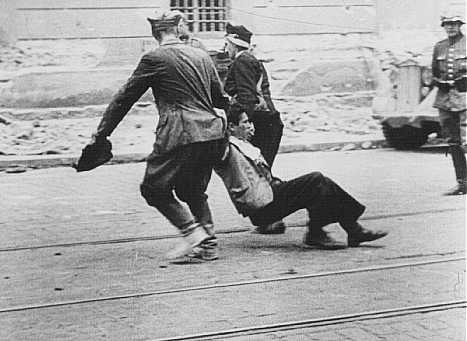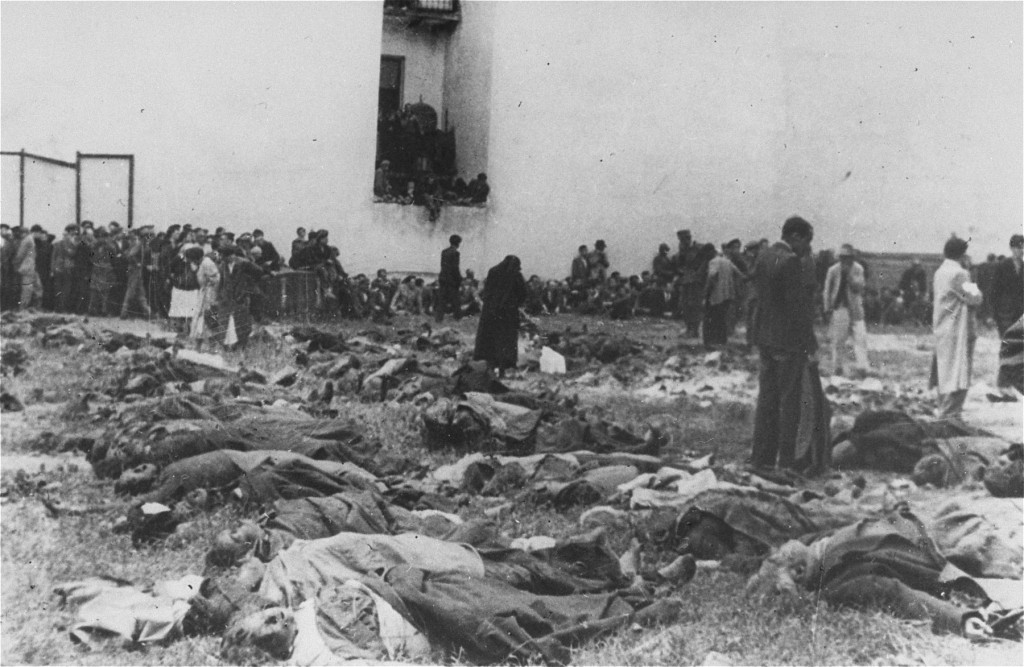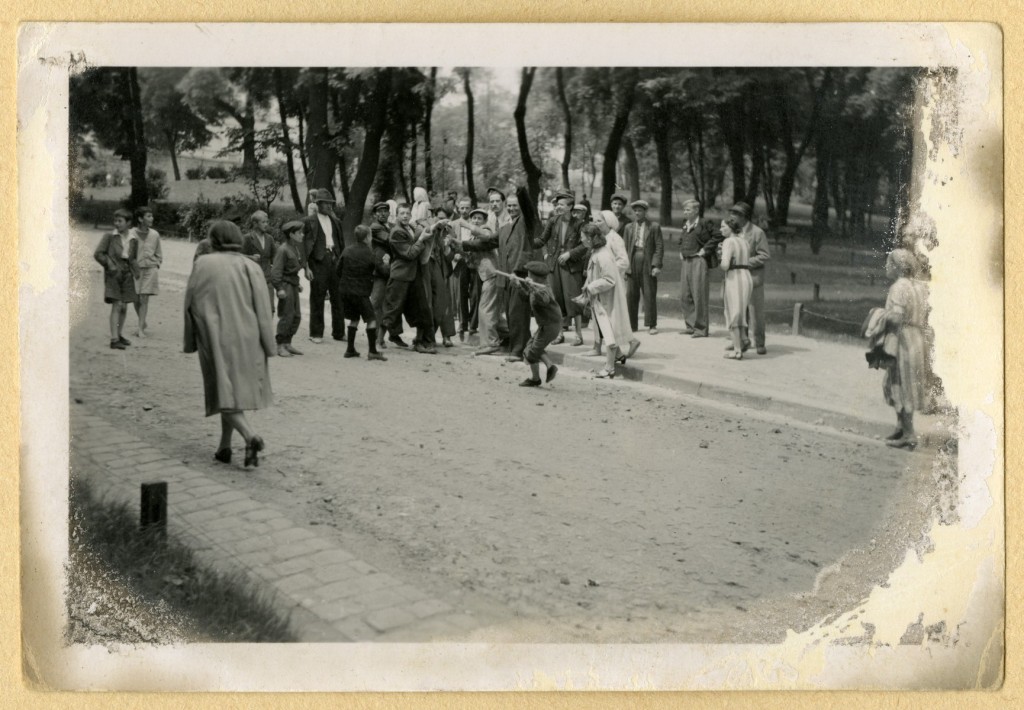
The Lwów Pogrom of July 1, 1941
German forces occupied Lwów on June 30, 1941. They immediately issued orders that led to antisemitic violence. Over the next 24 hours, what began as violence carried out by the German occupiers and their collaborators transformed into a pogrom with widespread participation. During the pogrom, some local civilians joined the occupiers and their collaborators in committing acts of mob violence against Jews in Lwów.
Key Facts
-
1
Between June 30 and July 1, German forces and some Ukrainian nationalist activists incited anti-Jewish violence among locals in Lwów. This violence grew into a pogrom, an outbreak of mob violence against Jews.
-
2
As part of this mob violence, Jews were brutally beaten, raped, and murdered. German forces also killed some Jews by shooting.
-
3
At least several hundred Jews, and possibly as many as a few thousand, were murdered during the Lwów pogrom.
On July 1, 1941, a pogrom against Jews broke out in the German-occupied city of Lwów, Poland (today Lviv, Ukraine). The term “pogrom” is a Russian word used to refer to violent attacks committed by groups of non-Jews against Jews. On that day, a mob violently attacked Jews. This mob was made up of German forces, members of a new Ukrainian militia, Ukrainian nationalist activists, and some local residents—including ethnic Poles and Ukrainians. The mob violence in Lwów included looting, beatings, rapes, and murders. Anywhere from several hundred to several thousand Jews were murdered during the pogrom. Many more were wounded.
Before the Pogrom: World War II and the Soviet Occupation of Lwów
World War II came to Lwów on September 1, 1939. On that day, German forces bombed the city as part of the invasion of Poland. Later that month, on September 17, the Soviet Union attacked Poland from the east. In the German-Soviet Pact, Germany and the Soviet Union had agreed to divide Poland between them. Lwów was located in eastern Poland in the designated Soviet sphere. The Soviets occupied Lwów on September 22, 1939.
Over the next 21 months, the Soviet occupiers upended everyday life in Lwów. They made new policies meant to transform existing social and economic structures. They also arrested, deported, and executed perceived enemies from all ethnic groups in the city. An influx of refugees from German-occupied Poland, including large numbers of Jews, further strained resources. These circumstances worsened preexisting tensions among the city’s three main ethnic groups: Poles, Jews, and Ukrainians. Antisemitism grew by the summer of 1941, as some non-Jews increasingly associated Jews with the Soviet regime.
In May and June 1941, shortly before Germany’s surprise attack on the Soviet Union, Soviet authorities launched another series of arrests. Many of those arrested were ethnic Ukrainians whom the Soviets suspected of having ties to an underground, right-wing nationalist group, the Organization of Ukrainian Nationalists (OUN). The OUN’s more radical branch, the OUN-Bandera (or OUN-B), was especially influential in Lwów and the surrounding region since 1940.
Nazi Germany attacked the Soviet Union on June 22, 1941, in an invasion code-named Operation "Barbarossa.” As a result, Soviet authorities had just days to flee Lwów. As they prepared to make a quick retreat, the Soviets massacred between 2,000 and 3,000 political prisoners. They killed these prisoners because they could not evacuate them. In their haste, the Soviets left the victims’ bodies in the prisons or in mass graves on the prison grounds. Most of the murdered prisoners were recently arrested OUN members and their families. The Germans discovered their bodies a few days later. This would serve as one of the catalysts for the anti-Jewish violence that erupted in Lwów.
June 30, 1941: The Germans Occupy Lwów
The German army occupied Lwów on June 30, 1941. From the start, the German war against the Soviet Union was extremely violent, particularly towards Jews and Communists. As German forces moved east, they brought their antisemitic policies and violence with them.
The Germans entered Lwów with activists from the OUN-B and a German military battalion made up of ethnic Ukrainians (many of whom also belonged to the OUN-B). In the hope of establishing a Ukrainian state, the OUN had been providing the Germans with military assistance and intelligence support ahead of Operation "Barbarossa.”
After arriving in Lwów, the Germans and OUN-B activists discovered the corpses of the Soviet prison massacre victims. German authorities ordered a newly formed Ukrainian militia to seize Jews. They took Jews by force from the streets and their homes. They then forced them to remove the corpses from three of the four prisons where the massacres had occurred just a few days earlier. They also verbally and physically abused the Jews as they took them to the prisons.
Once at the prisons, the German occupiers and members of the Ukrainian militia continued to insult and beat the Jewish men and women. The Jewish men had to remove or exhume the corpses. The women had to clean the decomposing bodies. The Jews were also forced to lay out the bodies for public display.

Throughout June 30, before the mob violence began, local Poles, Ukrainians, and other non-Jewish civilians witnessed the anti-Jewish violence carried out on the Germans’ orders. Crowds began to form on the streets and at the prisons as Jews were seized and abused. The Germans and OUN-B activists incited the crowds to violence by publicly blaming Jews for the prison massacre. This was despite the fact that Soviet authorities carried out the massacre. This false accusation invoked the antisemitic conspiracy theory called Judeo-Bolshevism. Judeo-Bolshevism blamed all Jews for communism. It was an important element of both Nazi and OUN-B propaganda. By citing this conspiracy theory, the Germans and OUN-B activists took advantage of existing antisemitic prejudices among local residents. Soon, some people in the crowds followed the lead of the Ukrainian militiamen and German forces. On their own initiative, people grabbed Jews and delivered them to the prisons. They also began robbing and attacking Jews.
July 1, 1941: The Pogrom
The anti-Jewish violence had begun on June 30 with the German occupation of Lwów. It then continued into July 1, when it turned into a pogrom. During the pogrom, crowds harassed, beat, and murdered Jews. These crowds included local Ukrainians and Poles, individual German soldiers, Ukrainian militiamen, and Ukrainian nationalist activists.
Mob Violence

Like the previous day, much of the pogrom violence occurred at the three prisons and on the surrounding streets. Crowds of civilians grew as the German forces and the Ukrainian militia forced Jews to remove, clean, and publicly display the decomposing bodies of the prisoners massacred by the Soviets. At the prisons, the civilian crowds also included people who were searching for missing family members and friends among the Soviet massacre victims. Again, non-Jewish civilians joined the Ukrainian militiamen and German forces in physically and verbally abusing the Jewish men and women. Members of this growing mob also robbed their Jewish victims.

Mob violence intensified throughout the day. This violence blurred the line between popular violence and violence committed as part of the German occupation of the city. Mobs included non-Jewish men and women of all ages as well as local civilians, German forces, Ukrainian militiamen, and OUN-B activists. They humiliated, physically abused, and attacked Jews at multiple locations around the city. Some Jews were forced to crawl to the prisons on their hands and knees. Others were forced to clean sidewalks with their bare hands or toothbrushes. The perpetrators cut off the beards of more traditional, religiously observant Jewish men. The crowds shouted antisemitic slurs and beat the Jews. OUN-B activists and German authorities continued to prop up the false conspiracy theory of Judeo-Bolshevism. For example, they forced some Jews to sing Soviet songs and cheer for Soviet leader Josef Stalin.
Perpetrators in the crowds, including teenagers and children, pulled Jewish women’s hair, manhandled them, and sometimes stripped them of their clothing. Some women were raped. The violence against Jews turned deadly as people from the crowds shoved, kicked, and beat Jews with various objects, such as sticks and tools. This mob violence resulted in the murder of an unknown number of Jews in Lwów.
The violence decreased the following day. Some violence continued into the afternoon. Again, Jews were tasked with removing, cleaning, and displaying the bodies of the Soviet prison massacre victims. By the end of July 2, German authorities ended the pogrom violence. Nevertheless, isolated incidents of local civilian attacks on Jews occurred throughout the week and again in late July.
Violence Committed by the German Occupiers
On the same day as the pogrom, the occupying German authorities murdered a few hundred Jews at the prisons. These Jews included people who were victims of the pogrom violence earlier that day. The Jewish men tasked with removing the corpses of the Soviet prison massacre victims were especially likely to be tortured and shot. This was the case, for example, at the Brygidki prison, where German forces shot up to 100 Jews.
Pogrom Victims and the Beginning of the Holocaust in Lwów

Conflicting eyewitness testimonies and the chaos of the first week of German occupation in Lwów make it difficult to estimate the number of Jews murdered in the pogrom.
The most commonly cited estimate is 4,000 victims. However, estimates range from 2,000 to 8,000. Recent scholarship suggests that these numbers are too high. These numbers most likely include both the pogrom victims and victims of executions perpetrated by the Germans throughout July 1941.
At minimum, several hundred Jews were murdered in the pogrom. Many more Jews were humiliated, brutally attacked, and wounded.
The violence in early July 1941 was just the start of the Holocaust in Lwów. Over the next three years, Jews in Lwów suffered forced labor, ghettoization, mass shootings, and deportations to killing centers. By the end of the war, most Jews in the region had been murdered.

